Catering for Learner Differences: MI, VAK and Other
Carolina Clerici, Argentina
Carolina Clerici is an English teacher and researcher at Facultad de Bromatología, Universidad Nacional de Entre Ríos, Argentina. E-mail: clericicarolina@hotmail.com , cclerici@fb.uner.edu.ar

Menu
Introduction
Background
For visual students
For auditory students
For kinaesthetic students
For other students
Final words
References
It is not easy to be original in the field of ELT since a lot has already been written. However, it is worth recycling easy techniques to make lessons interesting for different kinds of students and without spending too much time and money. During my last year in college, I noticed trainee teachers depend on ready-made activities and photocopies for lesson planning. It is true that they are an easy way to work since you only need to find a good activity to photocopy and hand it out to students. I am not denying how useful they are, especially nowadays, when teachers seem to rush from school to school and have hardly any time to plan. I do not mean the activities in course-books or photocopies should be banned. I just want to show my experience in making the most of them. Activities that help save up money and time is nothing new, in fact Widdowson (1978, p.55) once said “they can be used at any level, an important factor to consider for teachers, who often have little time for preparing lots of new materials”.
This article relies on Howard Gardner’s theory of multiple intelligences. Gardner stated that intelligence is not a singular phenomenon but rather a collection of seven distinct intelligences within every individual: linguistic, logical-mathematical, spatial, bodily kinaesthetic, interpersonal, intrapersonal and musical (Gardner, 1983). Besides, Visual/Auditory/Kinaesthetic model for learning preferences complements the understanding of Garner’s theory. NLP presuppositions are found along this work, as well.
Visual aids and visualization turn teaching more real and alive, and they help convey meaning. The value of visual aids depends on how much they contribute to the learning process. “Their function is not to make the lesson more colourful or to demonstrate the teacher’s versatility either in constructing or handling them, but to make learning more effective” (Byrne, 1976, p.128).
1. Cards
They are a good resource when courses are not very crowded. With large classes, it may take some time to get organized and a great number of copies.
1.1. Flashcards and pictures
Flashcards are good for teaching vocabulary, guessing games, oral compositions, etc. They are useful for the production stage, since they are non-verbal frameworks for language practice. They prompt dialogue production and role-playing. They stimulate interpretation and discussion and help students get their own viewpoints. “Students can go beyond what can actually be seen in the picture to what’s implied by it.” (Byrne, 1976, p.84). Flashcards and pictures should be large enough for students to be able to see them from the back of the classroom. They can be drawn using a thick felt-tip pen or cut out from magazines. The simpler they are, the more useful they will be for later activities. Students can draw pictures themselves, this is suitable for those with spatial intelligence.
1.2. Why are flashcards, pictures and visualization so important in learning a foreign language?
Taking into account Saussure’s linguistic sign, we know every sign is made up by a significant and a signified, i.e. a concept and an acoustic image. Picture 1 illustrates what happens in Spanish speakers’ minds when they learn a word, in this case “tree”:
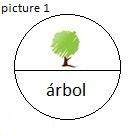
Since there is a tendency to associate the mother tongue directly to the foreign language, we could assume that the process in the mind of a Spanish speaker studying English could be the following (picture 2):
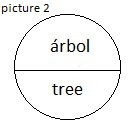
Flashcards and pictures may help associate directly the concept in English with the acoustic image, without going through translation. So making good use of visual aids may have a very positive effect on teaching vocabulary, and the result may be illustrated in picture 3:
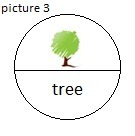
1.3. Cue cards and role cards
Cue cards and role cards guide students for pair work and role-play (see picture 4). These cards could be written on posters. Students can read them from the board and act out the situation.

For higher levels, cards can contain more complex instructions and they can guide more complex and longer dialogues (see picture 5).

2. Charts
It is quite easy and quick to copy a chart on the board. Charts and visual displays in general help students with spatial intelligence. The information on the chart can be used for different purposes:
2. 1. Talking about routines
The teacher can design a chart (see picture 6) on the board and ask students to fill in the first column with their own answers and the second column with their partner’s information. For this activity, students have to make an appropriate question to be able to get the information they need.

To check the activity, the teacher can ask students to make an oral report. They can use first or third person singular, according to the structures they are drilling.
2. 2. Writing about routines
Charts are useful prompts for writing. Picture 7 shows a chart, which takes very short to build on the board, can guide students to write about someone else. Thus, they practice routine and third person.

Possible outcome (PO): On Thursday, Tony gets up at 6:30 and has breakfast. He goes to school at 7:30. He has lunch at school at 1. Then, at 2, he goes to the club with John and Paul...
An alternative would be to ask students to fill out the chart with their own information, swap charts with their partner and describe his/her routine according to the information on the chart. Using their own lives to write about could motivate them. This kind of activity is good to help students with linguistic intelligence.
2. 3. Making comparisons
The following chart is useful to work on comparisons. They have to fill in the chart with their opinion (see picture 8):

PO: Buenos Aires is bigger and more modern than Paraná.
For comparisons to be authentic, it is a good idea to use charts with students’ information. The following example (picture 9) starts as pair work, where students collect information about their partner/s. The follow up activity may be a report, using the comparative or superlative forms according to the number of students participating in the activity.

PO: Mary has more sisters than I have. John has the most sisters.
2. 4. Games
A well-known game students love to play is “Battleship”. The teacher can ask students to draw the a chart on the board (see picture 10) while he/she explains how to play the game:
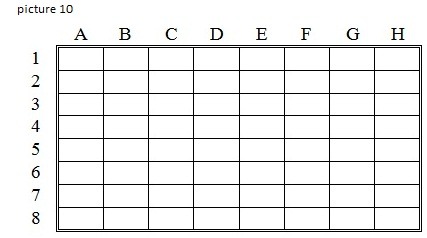
Class can be split into two teams. Students choose a combination of letter and number, where there is a question to answer or a true/false statement. If they answer correctly, they have a point. An alternative for this game is to hide pairs behind the squares, as a memory game. It is an interesting way to consolidate verb forms, especially irregular verbs. It is also useful to work with opposite adjectives, minimal pairs (phonetics), etc. These activities are very useful for students with logical mathematical intelligence.
3. Written posters
“If material is well-made, it is not only more motivating for the students to work with, but it is also more durable and can therefore be used with a number of different classes” (Hubicka, 1980, p.9). Picture 11 shows a gap-filling exercise on a poster could be designed in order to make it reusable.
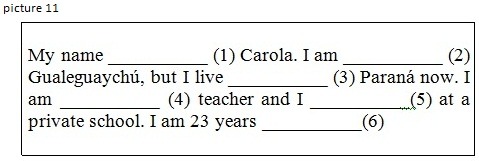
PO: 1- is 2- from 3- in 4- a 5- work 6- old
In the case of matching exercises, the teacher could prepare independent posters for the columns to be joined and stick them separately (see picture 12). In this way, students draw the lines on the board.

Visual aids are good for visual people, but they are not the only kind of students we have in the classroom, so it is good to keep in mind that auditory and kinaesthetic people do not always profit that much from visual aids.
1. Dictation
Although dictation has long been criticized and banned from the English classroom, it should not be considered a bad thing. Dictation is useful if we make good use of it. It is helpful to develop listening skills. Students are exposed to chunks of language and they are able to understand the general meaning.
Byrne (1986, pp.20-21) claims that dictation involves both listening comprehension and writing and it is more difficult than we consider. He suggests we should use it to practice specific pronunciation; such as minimal pairs and homophones. For this purpose, it is better to use sentences rather than whole passages. When using passages, he admits that they should not be too long or include sentences that cannot be split into meaningful units. If there are long sentences, we could repeat them as many times as necessary instead of dividing them up. While Byrne considers that dictating isolated words is bad, Revell and Norman (1997, p.37) do not seem to agree with him. They suggest column dictation as a good way to integrate the four skills. An alternative: give each student half of the dialogue to dictate to one another (p.139).
I tried the technique with a small group of advanced students. I told them to make five columns, one for each of the senses. Then I dictated some isolated words they had to put under the column they considered appropriate. I started with things like hamburger and TV which relate more directly to one of the senses and then words which are harder to classify, such as love and learning. When I told them to write their own names, they felt really surprised but they managed to put it under one of the columns. In pairs they explained what they had written. This exercise suits both interpersonal and intrapersonal intelligence. Dictation helps save time when we need some sentences or questions for students to work later on. It takes short and it allows working long. Picture 13 shows a gap-filling exercise as the introduction for a dialogue to produce in pairs, to revise simple past tense and location of places.

2. Songs
Songs are real English input easily found outside the classroom and they are usually very motivating. Songs are helpful for students with musical intelligence. They think via rhythms and melodies and they remember complex structures they have heard in songs. They can even make sense of complex abstract lyrics.
As Byrne thinks (1986, p.92) “they are real and once again provide a link between the classroom and the outside world. They are enjoyable and therefore memorable. Even if they present difficulties of comprehension, there is an incentive to overcome them”. Revell and Norman (1997, p.110) share this view, in the sense that they consider that songs help create a good rapport in the classroom since it maximizes similarities between teacher and students. Whenever the teacher is interested in something they like and knows about it, she is felt closer. “She meets them at their map of the world. Once we match, we can begin to influence, if we choose to, and if it is appropriate. In fact we can only influence from a matching position – from a position of rapport.”
2. 1. True/False exercises
The following activity is a consolidation lesson for modals to indicate: prediction, permission, advice and obligation. Students listened to the song “Father and Son” by Boyzone and said whether the statements were true or false.
- The son shouldn’t make a change now.
- The son should relax.
- The son should take a vacation.
- The son is allowed to get married.
- The son should react quickly.
- The son’s dreams will be there tomorrow.
- The father had to listen to his parents.
- The son will die.
- The son has to learn a lot.
- The father was allowed to cry
I checked this activity with a technique called pose-pause-pounce (Beaver, 1998, pp.33-34). I “posed” the question, I “paused” to have everyone think at the same time and then I “pounced” on someone for the answer. It is useful to keep them all on their toes. Harmer (1991) seems to agree since he considers that asking questions in a predictable order is demotivating and a possible reason of disruptive behaviour. However, in cases where questions are harder to answer, this technique could make students’ affective filter go up, for students might be under pressure. In this case they can volunteer to answer or they could be told in advance to think of it and take the time they need to get ready.
2. 2. Answer the questions
This activity was used to revise WH-questions. First, students listened to the song “Frozen” by Madonna and answered a set of questions that had been dictated. Although the language in the song was complex from the grammatical viewpoint, the activity was designed to be easy to understand at the first listening since the answers and the questions were the same as the words in the lyrics.
- What does he only see?
- When is he frozen?
- What is he consumed with?
- What does he waste his time with?
- When is he broken?
- What would happen if she could melt his heart?
- What should he know?
- What will happen if she loses him?
- What is love?
- What does “she” need?
At a higher level, where students are ready to listen to the song and process the information at the same time, the following activity can be successful: students listen to the song “Nothing compares to you” by Sinead O’Connor and answer the questions. Follow-up: students work in pairs to tell the story with their own words.
- When did he go away?
- What does she do every night?
- What does she do all day?
- Where does she have dinner?
- How does she feel without him?
- Where did she go for a solution?
- What did the person say?
- What happened to the flowers?
- What is living without him like?
- What does she want to do now?
2. 3. Tell the story
Story-telling is motivating for students with linguistic intelligence. To develop writing skills, a good activity could be the following. Students listen to the song “Norwegian Wood” by the Beatles and tell the story, the teacher may help them by providing some verbs in the infinitive.
have – be good – ask – stay – tell – sit – look – notice – be not – sit – bide – drink – talk – say – be time – tell – work – start – laugh – tell – crawl out – sleep – wake – be alone – fly – live – be good
2. 4. Listen and do
Students may listen to a song and have to do activities without actually producing any language. They may arrange paragraphs or put words in the correct place. In this activity with Alanis Morissette’s song “Hand in my Pocket” students are given the following chart and the words that appear below it. Their task is to think beforehand where the words go according to their meaning and then check as they listen to the song.
| I’m broke but | |
| I’m poor but | |
| I’m short but | |
| I’m high but | |
| I’m sane but | |
| I’m lost but | |
| What it all comes down to. Is that everything’s gonna be fine, fine, fine. |
| I’ve got one hand in my pocket and | |
| I feel drunk but | |
| I’m young and | |
| I’m tired but | |
| I care but | |
| I’m here but | |
| I’m wrong but | |
| What it all comes down to? Is that everything’s gonna be quite all right? |
| I’ve got one hand in my pocket and | |
| What it all comes down to? Is that I haven’t got it all figured out just yet? |
| I’ve got one hand in my pocket and | |
| I’m free but | |
| I’m green but | |
| I’m hard but | |
| I’m sad but | |
| I’m brave but | |
| I’m sick but | |
| What it all boils down to? Is that no one’s really got it figured out just yet? |
| I’ve got one hand in my pocket and | |
| What it all comes down to, my friends? Is that everything’s just fine, fine, fine? |
| I’ve got one hand in my pocket and | |
I’m chickenish - I’m focused - I’m friendly, baby - I’m grounded - I’m happy - I’m healthy, yeah - I’m hopeful, baby - I’m kind - I’m laughing - I’m overwhelmed - I’m pretty, baby - I’m really gone - I’m restless - I’m sober - I’m sorry, baby - I’m underpaid - I’m wise - I’m working, yeah - the other one is flicking a cigarette - the other one is giving a high five - the other one is hailing a taxi cab - the other one is playing the piano - the other one’s giving a peace sign
3. CDs
Workings with CDs may be boring if the lyrics are too long and students lose the gist. It is better to use shorter songs, split them up, or make pauses. It is possible to ask students to listen to the song and tell later what they remember. Littlewood (1990, p.68) offers an interesting classification of listening activities.
3. 1. Performing physical tasks
This kind of activity is usually associated with Asher’s Total Physical Response. However, it is not the only way of having students do things after verbal and non-verbal prompts.
- Identification and selection: Students need a set of pictures, they listen to the tape and have to decide what picture is being referred to.
- Sequencing: Students can be given pictures and, while they listen to the tape, they place the pictures in the correct sequence.
- Locating: Students place items into their appropriate location according to the tape. They can use linguistic reference from the lyrics to locate the song or the singer. They can work with the singer’s biography or they can place songs in time.
- Drawing and constructing: While students listen to a description or discussion, they can draw something. They can create a whole comic strip after listening to a song or story. They can turn it into drama.
3. 2. Transferring information
Students can listen and put the information into a different format, like a chart or a gap-filling exercise. I used this technique with adults at a private institute. I made them listen to a tape where a person described his meals and students had to draw the tables with the food they heard. Then they compared pictures.
3. 3. Reformulating and evaluating information
Students reformulate the text in their own words, they can make a summary or take down notes.
1. Simulation
Littlewood (1981, pp.49-62) grades activities taking into account teacher-control and learner-creativity “As this control becomes less tight and specific, so there is increased scope for the learners’ creativity. In this respect, the activities can be viewed as part of a single continuum which links pre-communicative and communicative activities.”

2. Games and kinetic activities
Games and kinaesthetic activities can help students with bodily kinaesthetic intelligence and find it hard to be quiet while they learn.
2. 1. Guessing games
Guessing games in pairs are easy to settle. For example, when teaching the present continuous tense, a quick follow up activity could be the following: Students work in pairs; one of them writes a sentence such as “I’m swimming”; the other student has to guess, either by asking (Are you reading? Are you sleeping?) or by giving a statement (You are reading. You are sleeping.), according to the structures that they know.
2. 2. Total Physical Response
Activity and learning are closely linked and students need activities to stimulate the mind. Asher already declared that it is possible to learn a language through the association between language and movement. Taking his theory to the classroom, we can mention “Simon says” as the best example of a game or kinetic activity.
3. Realia
Real objects need no special preparation. Authenticity is very important in the classroom, as many students do not learn effectively with “let’s pretend this” or “imagine that”. They need real-life examples and real reference. At secondary school I gave students different old and useless objects, which they were supposed to sell to the rest of the class. The objects were an old pin, a pencil-sharpener, a rubber band, a tiny plastic bag and a button. They had to use their imagination to convince the group that their product was worth buying. The objective was to practice passive structures to describe objects, such as:
It is called...
It is used to...
It can also be used to...
It was invented by...
Realia may also be the classroom, the teacher and the students. Brumfit and Johnson (1979, p.203 see picture 14) include activities that are based on the resources available in every classroom.
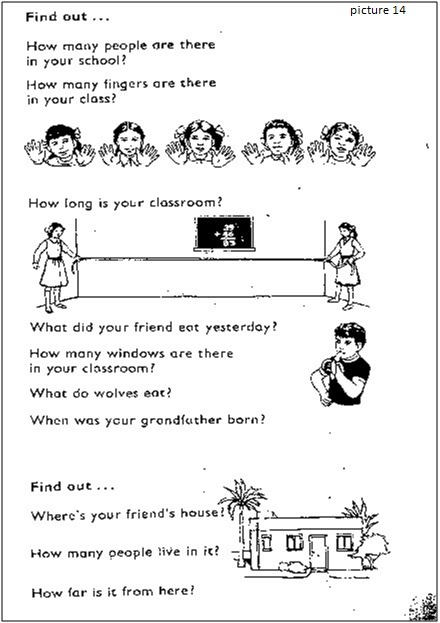
And those who do not seem to learn?
There are five questions that are essential when we deal with learning:
- Where? → People learn everywhere.
- When? → People learn all the time.
- What? → Things that touch us in some way.
- Why? → Because we are curious about the world.
- How? → We get the information through our senses and then the brain takes over.
If we want our students to learn English, we should do interesting things to touch them, appealing to all senses at the same time. If students do not seem to learn the foreign language we are trying to teach, it might be because we are not teaching it in the same way they acquired their mother tongue. Beaver (1998, p.122) makes some suggestions:
- We were born with a need to communicate in order to survive.
- Our attention was on the communication, not upon the language itself.
- We modelled other members of our family.
- We used trial and error until we were understood.
- All verbal communication was greeted with pride, joy and encouragement.
- We were learning in a safe environment.
- We were not constantly corrected.
- We have an inborn understanding of how language works.
- We did not have to learn regular verbs before being allowed to talk.
- We were allowed to learn in our own way.
There is no method that can work at perfection. There is only a teacher with ideas and students. And there are some principles that govern the classroom:
- Mind and body are interconnected, and we should bear this in mind every time we plan a class.
- Everyone has a different map of the world, people have different ways of learning.
- Being wrong means that there is still a choice to be better. There is no failure, only feedback... and a renewed opportunity for success.
- The resources we need are within ourselves. Teaching can take place even without any resources at all. We need imagination and will; the rest comes alone.
- Communication is non-verbal as well as verbal. Drama, games and songs are included under the heading of non-verbal, which sometimes is put aside in the classroom.
- All behaviour has a positive intention, so when students do not behave properly, they might be trying to let us know that our ways are not their ways. Time to change.
My work is not meant to be a recipe but a humble contribution, bearing always in mind that being creative is the only way to success in teaching. As Widdowson once said “I am not trying to present a conclusive case but to start an inquiry.” (Widdowson, 1978, p.x)
Beaver, D. (1998). NLP for Lazy Learning. New York: Element Books limited.
Brumfit, C.J. and Johnson, K. (1979) The Communicative Approach to Language Teaching. London: OUP.
Byrne, D. (1976). Teaching Oral English. London: Longman.
Gardner, H. (1983). Frames of mind. New York: Basic Books.
Harmer, J. (1991). The Practice of English Language Teaching. London: Longman
Hubicka, O. (1980). Group and Pair Work. Practical English Teaching 1. Publicação da Royal Society of Arts Certificate in the Teaching of English as a Foreign Language.
Littlewood, W. (1990). Communicative Language Teaching (12th printing). London: Cambridge University Press.
Maley, A. and Duff, A. (1978). Drama Techniques in Language Learning. London: Longman.
Revell, J. and Norman, S. (1997). In Your Hands. London: Saffire Press.
Widdowson (1978). Teaching Language as Communication. Oxford: Oxford University Press.
Willis, J. (1995). Teaching English through English (16th impression). London: Longman.

Please check the How the Motivate your Students course at Pilgrims website.
Please check the Building Positive Group Dynamics course at Pilgrims website.
Please check the NLP for Teachers course at Pilgrims website.
Please check the Teaching English Through Multiple Intelligences course at Pilgrims website.


|